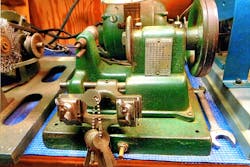Back Page March 2020
Twenty Years Ago
Jerry Levine described a new 515 Convert-A-Bolt safelock by Ilco Unican. Tim O'Leary outlined various standalone access control systems and explained why locksmiths should install them. James Glazier suggested using photography for investigative locksmith work. Locksmith Mike Ferrill took a vacation to Hale Koa Hotel in Hawaii and contributed an article on institutional locksmithing at the hotel. Writer Dick Zunkel provided a lesson in using magnetic locks with delayed egress. Tiny's Tips showed the procedure for servicing Ford Ranger pickup locks, including the unusual hidden-tire lock. Jerry Levine listed the various LAB pin kits that are designed specifically for individual lock manufacturers, such as Kwikset, Sargent and Yale. Each kit contains bottom pins that have the same nose shape as original pins. Jerry Levine continued with a listing of popular Auto Security Product (ASP) pin kits. Charles Stephenson continued with part five in his series on safe-lock components and functions. Billy Edwards answered the eternal question, "Who Owns a MK System?" Still an important question. Milt Wolferseder serviced an Intersec safe cabinet. Tony Vigil, High Tech Tools, offered a system for unlocking Mercury Cougars.
Ten Years Ago
Tim O'Leary reported on the new Alarm Lock Trilogy Networx wireless access control system. Jerry Levine described the various wireless communicating lock systems on the market. Tim O'Leary tested standalone lock systems available from Securitron and Essex. Jerry Levine listed various available padlock hasps and hasp manufacturers. Steve Young suggested essential locksmith tools he uses in his business every day. Gale Johnson reported on the Schlage SecureKey owner rekeyable lock system. Schlage later removed SecureKey cylinders from the marketplace. Jerry Levine introduced GE P500 KeySafes designed for optimum key control. A one-man door installation tool called DoorJak was the topic of an article. Gale Johnson wrote on counter sales displays available from American Lock. Listings of popular motorcycle blanks were the feature of another article. Locksmith Jeremy Reeder suggested using tamper-resistant screws for lock installations.
Back to 1934
Right in the middle of the Depression, car manufacturers decided to change lock designs. In 1933, Chrysler went with a blank that had an offset that was made by Yale, and in 1934, General Motors used a Briggs & Stratton double-sided key system. Both types lasted only through 1934.
A Washington state locksmith recently requested information on fitting keys to a 1934 Cadillac glove-box lock. The lock cam covers the retainer nut. To remove the cam, the lock plug must be rotated one-quarter turn. An internal spring in the cam then can be depressed, allowing the cam to be removed. We still are waiting to hear whether the locksmith was successful in fitting a key. He also sent a picture of the Briggs & Stratton key machine available in the 1930s for cutting those keys.
